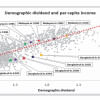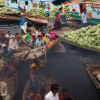Three realities, one future: Why youth voice must shape population policy

Every year, on July 11, World Population Day is observed by the global community reflecting on how demographic trends shape our lives and futures. This year's theme—"Empowering young people to create the families they want in a fair and hopeful world"—is especially timely as concerns over population decline grow amid an uneven demographic landscape where young people's reproductive choices are increasingly central.
As of 2024, the global population stands at 8.2 billion and is projected to peak at approximately 10.3 billion by the 2080s, before entering a gradual decline. But this growth is slowing down dramatically and unevenly. Before 2024, the population size peaked in 63 countries, while a further 48 are expected to peak between 2025 and 2054. Populations in the remaining 126 countries are projected to grow until at least the late 21st century, or even beyond 2100. More than half of all countries now have fertility rates below the replacement level of 2.1, with some as low as 0.7. In contrast, countries in sub-Saharan Africa and South Asia, including Bangladesh, continue to grow, albeit more slowly.
Importantly, nearly 80 percent of global population growth through the mid-21st century will be driven by population momentum, not high fertility. This momentum arises from a historically large youth population—1.8 billion aged 10-24 years—due to previously high birth rates, along with more women entering reproductive age. These figures suggest that low fertility is less about a declining desire to have children and more about unmet needs and structural barriers that prevent young people from forming families safely and freely.
Bangladesh, with a population of around 176 million as of June 2025 (UNFPA), stands at a critical juncture in the global demographic transition. Fertility has dropped from more than 6.0 births per woman in the 1970s to approximately 2.0 in 2024. Life expectancy now exceeds 73 years, and both maternal and child mortalities have declined significantly. Yet, these achievements often obscure underlying demographic vulnerabilities. Although Bangladesh has reached replacement-level fertility, a large cohort of youth—the legacy of past high birth rates—continues to shape its age structure, with a quarter of the population aged under 30 years. In the coming decades, this group will move into older age, while fewer young people enter reproductive age as birth rates decline.
Consequently, Bangladesh risks missing the full benefits of its demographic dividend—projected to begin closing by 2040—and facing a shrinking working-age population. This shift towards an ageing society raises urgent questions about sustaining growth, supporting the elderly, and securing future well-being. While such trends have prompted pronatalist policies globally, Bangladesh can respond more effectively by investing in and empowering today's youth to build a resilient and inclusive future.
Today, young people in Bangladesh are more educated, connected, and ambitious than any previous generation. Yet, their family choices are often shaped or constrained by tradition, poverty, gender norms, and structural inequality. As a result, they face one of three demographic realities: lower fertility by choice, delayed or forgone family formation due to uncertainty, or early family formation under coercion. These overlapping experiences underscore the need for a more nuanced, youth-centred approach to population and development policy.
A growing number of young people in Bangladesh—still a relatively small group, mainly from urban, middle- and upper-income families—are choosing to delay marriage and parenthood. Many fall into the first demographic pattern, often prioritising education and personal or professional goals. Access to mobile technology, global media, and digital learning has expanded their horizons, particularly for females, who increasingly view education and careers as central to their identity. These young people enjoy greater reproductive autonomy, though it remains incomplete.
In contrast, a larger and more visible segment of Bangladesh's youth falls into the second demographic reality: those delaying or forgoing family formation not by choice, but due to gender norms, restrictive masculinities, and economic pressures. In Bangladesh, girls' marriages are closely linked to family honour and security, while boys are expected to attain financial stability before marrying. However, the current socioeconomic conditions often undermine these expectations. Youth unemployment remains high among the highly educated, reaching 10 percent in 2024. Those who do find work are often in low-paid, insecure, or informal employment, falling short of both personal aspirations and societal standards. As a result, many delay marriage while seeking stable employment, often until they reach the upper age limit of 32. Even when couples marry outside traditional norms, rigid expectations persist. Families—especially in rural areas—continue to influence decisions on when to have children, how many, and of what gender. Fertility remains tied to social approval, with many—particularly women—feeling pressured to bear children in order to secure their place in the family. Reproductive choices are frequently shaped by subtle coercion—through obligation, expectation, and fear of rejection or violence.
At the same time, many young people face a third demographic pattern: forming families too early. An estimated 51 percent of women aged 20-24 years were married before the age of 18 (2021), often followed by adolescent pregnancies without the girl's informed consent or readiness. This reality is driven by poverty, social insecurity, limited education, and deeply embedded cultural norms that view girls as economic and social burdens, regardless of their consent. For these youths, family formation is not a path to independence but the beginning of lifelong dependency and vulnerability.
Together, these three demographic realities create a highly uneven and often inequitable fertility landscape in Bangladesh. While the national fertility rate appears stable, near replacement level, it masks deep inequalities: for some, fertility is a choice, while for others, it is shaped or constrained by social expectations and coercion. For many young people, forming the families they want remains a struggle against tradition, poverty, gender norms, and limited economic opportunities. This struggle is intensified by rising unemployment, the cost of living, political instability, and ongoing challenges such as climate change and displacement.
To build a fair and hopeful future, Bangladesh must dismantle the structural barriers that limit young people's choices and affirm their rights to dream, decide, and define what family means to them. Only by investing in its youth can the country realise the promise of its demographic transition.
Dr Md Nuruzzaman Khan is associate professor of population science at Jatiya Kabi Kazi Nazrul Islam University, and a research fellow at the University of Melbourne, Australia. He can be reached at [email protected].
Views expressed in this article are the author's own.
Follow The Daily Star Opinion on Facebook for the latest opinions, commentaries, and analyses by experts and professionals. To contribute your article or letter to The Daily Star Opinion, see our submission guidelines.

 For all latest news, follow The Daily Star's Google News channel.
For all latest news, follow The Daily Star's Google News channel. 










Comments